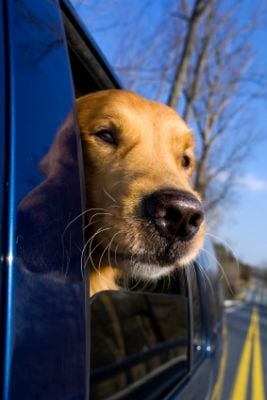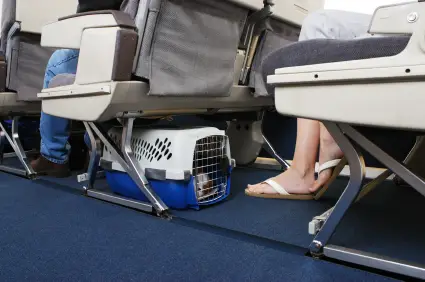
This is a placeholder text
Group text
 Traveling with Your Dog
Traveling with Your Dog
By Kim Downing Dogs are a part of the family, and they go everywhere with us. Whether it just a short trip for an errand, to the park, to a training class, or to a competitive event, you have to plan ahead to travel safely with your dog.
In the Car:
While we feel safe when driving in the car, it is actually one of the more dangerous activities that we do on a regular basis. Accident prevention experts recommend having no loose items of any kind in the car, if possible, as these all become projectile items upon impact in the event of an accident. This includes dogs. A dog in the back seat can be thrown to the front and through a windshield.Even under normal circumstances dogs can be a distraction to the driver, particularly if the dog is allow to freely move around the car from seat to seat. A class example of why dogs can’t be allowed to roam freely in the car occurred to famous horror book author Stephen King when he was hit by a minivan while he walked along the road. Reports showed that the driver of the vehicle was temporarily distracted by a dog riding loose in the car and had taken his eyes off the road.
It is important to take safety precautions when traveling by car with the dog whether it is a short trip or an extended travel. Dogs should be prevented from moving freely in the car. There is more than one way to accomplish this although most feel that a crate provides the best protection for long travels. Other options include using a seatbelt to fasten the dog in place in one of the backseats or using a vehicle barrier to separate the back area from the front area. Some car manufacturers offer this with their new models for an added fee or you can purchase a general one made to fit more than one style of car.
By Plane:
Unless you have the luxury of a very small breed, your dog won’t be able to travel in the same area of the plane as you. Only dogs that are quite tiny and can fit inside a carrier under a seat are allowed to ride in the passenger area. Larger dogs must ride within the cargo area with the luggage.There are strict regulations for shipping dogs alone or bringing them with you. The cargo hold area of a plane is not regulated like the passenger section so there are temperature fluctuations which can be harmful to pets. The airlines had multiple incidents of dogs dying while flying, so now restrictions are quite tight on when and how dogs may fly.
If you are planning a trip and want your dog to fly with you, you need to speak with the airlines before fully investing in the tickets. Make sure that the temperatures are okay for flying. During the winter and especially the summer, there are temperature restrictions where they will not fly a dog above or below a certain temperature.
You’ll also need to know how the dog will have to fly. There is usually some type of paperwork you will need to take care of. Additionally, the dog must fly in an approved carrier for the airlines. For large dogs this is normally a plastic, airline type crate with ventilation holes. The crate can’t be too large for the dog or too small, so you’ll need to specifically know what the restrictions are on sizing. If you get to the airport and the staff doesn’t feel that the crate matches the sizing requirements, your dog will miss the flight.
Accidents happen! Be prepared. Crates have been known to fall apart or sometimes well meaning individuals have gotten dogs out of the crates only to lose them. You’re best to place multiple labels on the crate that indicate who the owner of the dog is, how to contact this person, and what the name of the dog is. You should also indicate where the dog came from and where it is going on the travel….just in case he misses the plane or is accidentally placed on a different one.
Be sure to reinforce the crate. Some people like to use duct tape or tie straps over the screws for extra protection as well as to secure the front clasp on the gate so it doesn’t accidentally pop open.
Lastly, know what is allowed inside the crate. Airlines are specific on the regulations as to what has to be inside the crate and what can’t be. Normally some type of absorbent material in the crate is allowed in case of an accident by the dog.
 Other Things to Consider When Traveling:
Other Things to Consider When Traveling:
The best piece of advice is to always hope for the best but plan for the worst! This means considering what might be needed in the event of a problem during your travels. What should be included on a trip:
- I would suggest making sure that your dog is wearing a collar with a permanent id tag. In addition, you should consider creating a temporary id tag that would include the name and phone number of a local contact person, if you have one.
- Carry with you an info page on your dog. It should include a recent photo or two (from different angles) of your dog and any important medical history. This can be used in the event he is lost or if you need to seek veterinary attention.
- Look ahead to where you will be traveling and locate a few veterinary numbers such as an emergency vet.
- Make sure you have a checklist of what your dog needs: bowls, food, collar, leash, favorite toys, any medication, treats, etc. Consider carrying water from home initially and add ice to any new water your dog drinks on the road. This helps lessen intestinal upset.
- A first aid kit can be a good idea, especially if you plan to go trail walking, hiking, or any activity where an accident could occur.
The last thing for extra consideration is where you will be staying. Always check with hotels before going in. Not all of them are dog friendly or have areas to walk dogs for bathroom breaks. Try to ask a friend or family member in the area, if possible, what hotels have the best green space around them.
The same advice applies to any RV parks or camping sites. Many have dog restrictions so make sure the one you are planning to visit accepts your breed of dog.
Contact information Disclaimer Privacy Statement Copyright Information Terms of Service Cookie policy ↑ Back to top




